SUMMARY HIGHLIGHTS
- Tonkotsu ramen (aka Hakata ramen) is a signature dish of Fukuoka.
- Yatai food stalls are a symbol of Fukuoka. Don’t miss them.
- Nanzoin Temple and its giant reclining Buddha is an easy day trip from Fukuoka.
I didn’t know what to make of Fukuoka at first. It’s a bit sterile in feel and lacking in the cultural attractions you’d expect from old Japan. Compared to more popular cities like Tokyo, Kyoto, and even Osaka, it felt more like a stopover, an entry point into Kyushu en route to more interesting destinations within the region.
But after my second and third visits, the city did start to grow on me. After I stopped looking for the usual attractions I had come to expect from Japan, I found that Fukuoka had more to offer than originally thought. Being one of the largest cities in Japan, it’s a modern metropolis that runs at its own pace – busy but unhurried, slower than the more touristy cities but interesting enough to make me want to come back.
Fukuoka may not be what many people expect from Japan but in some ways, that can be a good thing. I hope this city guide gives you enough reason to visit.
VISIT FUKUOKA QUICK LINKS
To help make your Fukuoka trip planning a little easier, I’ve put together links to recommended hotels, tours, and other travel-related services here.
HOTELS
Top-rated hotels in Nakasu, one of the best areas to stay for first-time visitors to Fukuoka.
- Luxury: The Royal Park Canvas Fukuoka Nakasu
- Midrange: Hotel Resol Trinity Hakata
- Budget: HOTEL LiVEMAX Hakata Nakasu
EXPERIENCES
- Sightseeing Tour: Fukuoka City, Half Day Heaven Tour
- Yatai Tour: Nakasu Food Stall Private Guided Tour with Tastings
- Ramen Tour: Local Ramen Experience in Downtown Fukuoka
- Sake Tour: Hakata Sake and Gastronomic Delicacies Tour
- Cooking Class: Cooking Classes in Fukuoka
OTHER SERVICES
- Travel Insurance (non-US residents get 5% off)
- Airport Transfers
- Kyushu Rail Pass
- Japan Rail Pass
- Japan eSIM
GUIDE TABLE OF CONTENTS
FUKUOKA AT A GLANCE
Fukuoka is Kyushu’s biggest city and the capital of Fukuoka prefecture. Bordered by the Sea of Japan, it’s been an important harbor city for centuries thanks to its proximity to the Asian mainland. Geographically, it’s closer to Seoul than it is to Tokyo.
Located on the northern shore of Kyushu island, Fukuoka is home to one of the busiest international airports in Japan. It’s a convenient entry point for people looking to explore the Kyushu region and the rest of the country.
Compared to Tokyo or Kyoto, Fukuoka doesn’t have as many tourist attractions but one thing it is famous for is its food. It’s the birthplace of tonkotsu or Hakata ramen – one of the most popular types of ramen in Japan.
Fukuoka also has the largest number of yatai or Japanese street food stalls in the country. So popular are yatai in Fukuoka that they’ve become an iconic symbol of the city.
BEST TIME TO VISIT FUKUOKA
Fukuoka is a year-round destination. Because of its southern location, it experiences mild winters so you should have a pleasant time no matter when you go. But like many destinations in Japan, the spring and fall seasons are typically the best times to visit thanks to the cherry blossoms and autumn leaves.
If you’d like to experience a festival on your visit, then it’s best to go in the first half of July for the Hakata Gion Yamakasa Festival. It’s a fun festival that culminates in a time trial race on July 15, when beautifully decorated floats weighing a ton each are carried by dozens of runners along a 5 km (3.1 miles) course through the city.
WHERE TO STAY IN FUKUOKA
Fukuoka is a big city but most of its top attractions are located in a relatively compact area. For convenience, first-time visitors should look for accommodations in Tenjin, Nakasu, or around Hakata Station.
I’ve created the color-coded map below to help you understand where these recommended areas are. (Please note that marked areas are approximations only)
RED – Around Hakata Station
GREEN – Nakasu
PURPLE – Tenjin
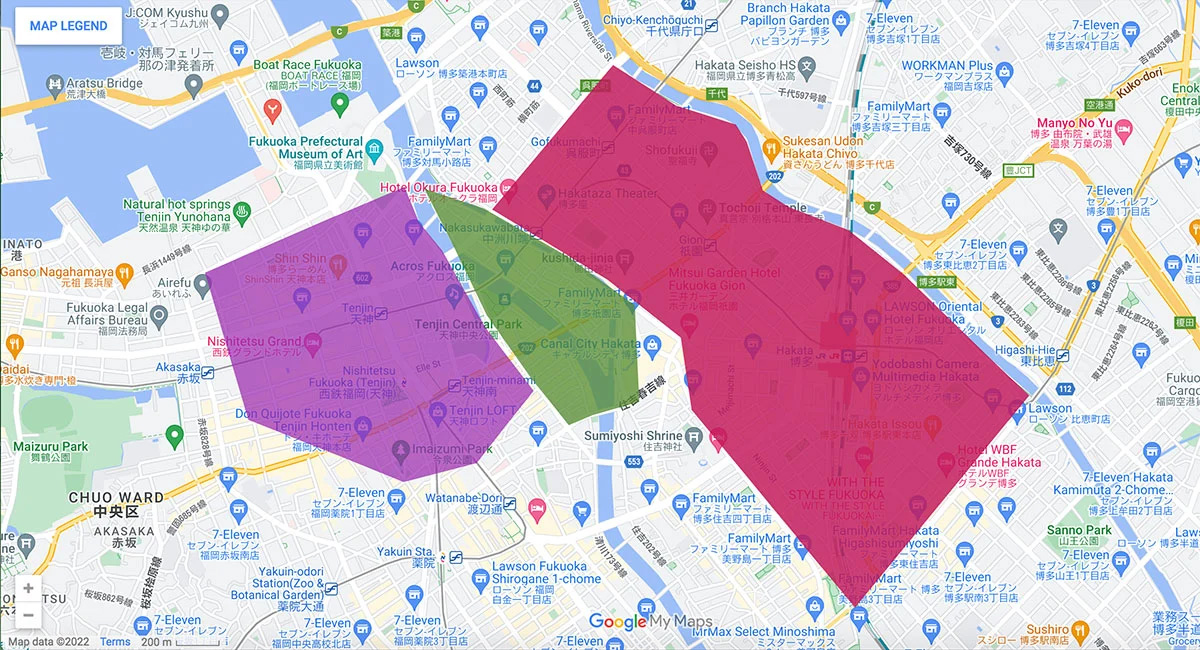
AROUND HAKATA STATION
Hakata Station is the main station in Fukuoka and a convenient area to stay for first-time visitors to the city. Aside from the train and bus stations, it’s where you’ll find some of Fukuoka’s top tourist attractions like Kushida Shrine, Sumiyoshi Shrine, and Canal City Hakata.
If you’d like to stay close to Hakata Station, then you can check these links for hotel listings in the area: Booking.com | Agoda. Here are a few of the top-rated hotels around Hakata Station:
- Luxury: Miyako Hotel Hakata
- Midrange: Hotel Clio Court Hakata
- Budget: Hostel TOKI
NAKASU
Nakasu refers to a district on a small island in Hakata Ward. It’s a lively entertainment quarter filled with nightclubs, restaurants, izakayas, and karaoke bars. It’s home to the original branch of the Ichiran ramen shop and the most popular cluster of yatai food stalls. Of all the areas I’ve stayed at so far in Fukuoka, Nakasu is my favorite.
Check out Booking.com for hotel listings in Nakasu. Listed below are some of the top-rated hotels in the area:
- Luxury: The Royal Park Canvas Fukuoka Nakasu
- Midrange: Hotel Resol Trinity Hakata
- Budget: HOTEL LiVEMAX Hakata Nakasu
TENJIN
Tenjin is one of the most popular neighborhoods in Fukuoka. It’s a well-known shopping area with lots of restaurants, cafes, bars, and nightlife options. If you like to party, then Tenjin is probably where you’ll want to stay.
You can search for accommodations in Tenjin on Booking.com or Agoda. Check out some of the top-rated hotels in the area:
- Luxury: Solaria Nishitetsu Hotel Fukuoka
- Midrange: Richmond Hotel Tenjin Nishi-Dori
- Budget: Nishi Nakasu apartment 301
THINGS TO DO IN FUKUOKA
Eat Street Food at a Yatai Stall
These yatai stalls are my favorite thing about Fukuoka. I don’t see them too often in Japan so I always make sure to enjoy at least one meal at a yatai on every trip to Fukuoka.
A yatai is the Japanese version of a street food stall. Street food isn’t as widespread in Japanese culture so these yatai stalls are one of the few times you can experience authentic street food in Japan.
You can find yatai in other Japanese cities but Fukuoka has the most, about 150 clustered in different parts of the city. The most popular cluster is in the southern end of Nakasu. You’ll find about twenty yatai attractively situated by the river. They’re a beloved symbol of Fukuoka and a great way to rub elbows (literally) with locals.
I always eat at yatai on my own but if you’re feeling a little intimidated, perhaps due to the language barrier or tight space, then you may be interested in this guided Yatai hopping tour.

Visit a Shrine
Kushida Shrine is one of the most important Shinto shrines in the city. It was built in 757 and regarded by locals as the temple guardian of Fukuoka.
If you visit Fukuoka in July, then you’ll get to experience the aforementioned Yamakasa Gion Matsuri. It’s the biggest festival in the city and features large elaborately decorated floats measuring up to ten meters tall and weighing over a ton.
On the last day of the festival, hundreds of men representing Hakata’s neighborhoods compete in a race while carrying these giant floats. The largest of these floats are then put on display at Kushida Shrine until the next festival.
Located about one kilometer northwest of Hakata Station, you can visit Kushida Shrine on your own or go as part of a guided city tour.
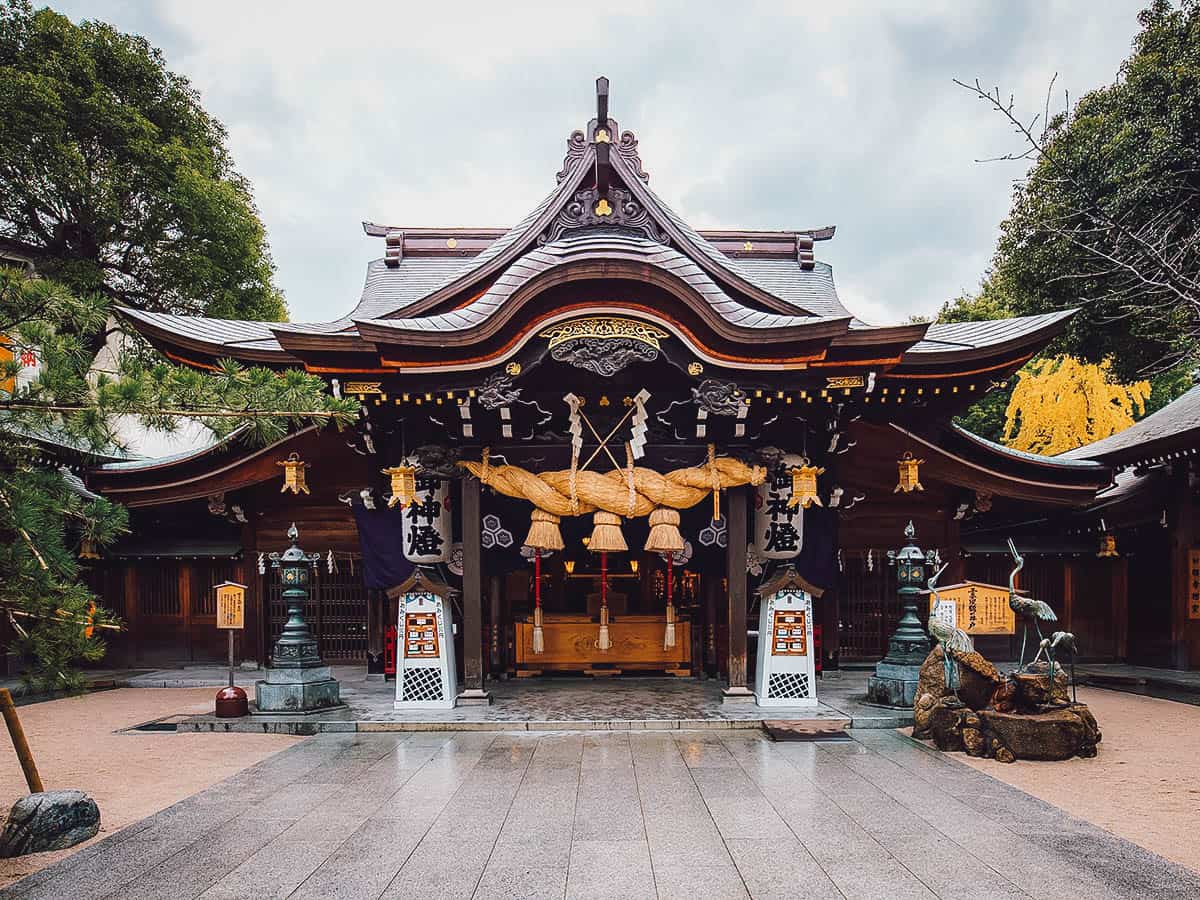
Photo by Nattee Chalermtiragool via Shutterstock
About 1 km south of Kushida Shrine is Chikuzen Sumiyoshi. Also known as Sumiyoshi Shrine, it’s a Japanese Shinto shrine once regarded as the most important shrine of the Chikuzen area (northern part of Fukuoka prefecture).
Built over 1,800 years ago, Chikuzen Sumiyoshi is the first of nearly 2,000 Sumiyoshi shrines in Japan. Sumiyoshi shrines are built in dedication to the Sumiyoshi sajin or the three Shinto gods of the sea and sailing.
Highlights at Chikuzen Sumiyoshi include the main hall, which is designated as a National Treasure of Japan, and the copper axe and sword which are regarded as important cultural properties of Fukuoka.
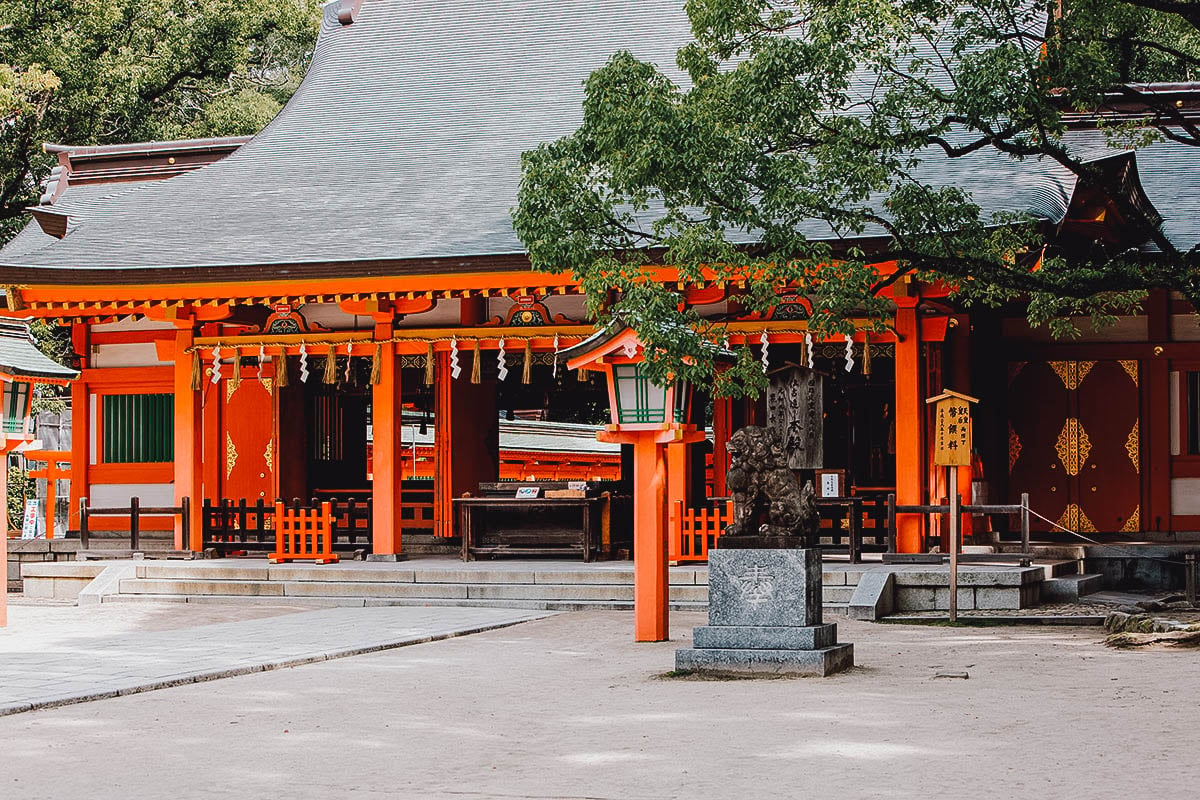
Photo by [email protected] via Depositphotos
Slurp a Bowl of Hakata Ramen in a Solo Booth
Tonkotsu or Hakata ramen is my favorite type of ramen, which is part of the reason why I like visiting this city. A signature dish of Fukuoka, it refers to a type of ramen made by boiling pork bones for several hours over high heat until the marrow seeps out and turns the broth milky. It’s rich and comforting and unbeatable on a cold winter night in Japan.
There’s no shortage of excellent Hakata ramen shops in Fukuoka but I suggest trying it at the original branch of Ichiran. If you’ve never heard of Ichiran, it’s a popular chain of ramen shops specializing in Hakata ramen.
Not only does Ichiran serve some of the tastiest ramen, but they’ve become famous for their solo dining booths designed to help you focus on one thing and one thing only – slurping down that irresistible bowl of Hakata ramen. Oishi!
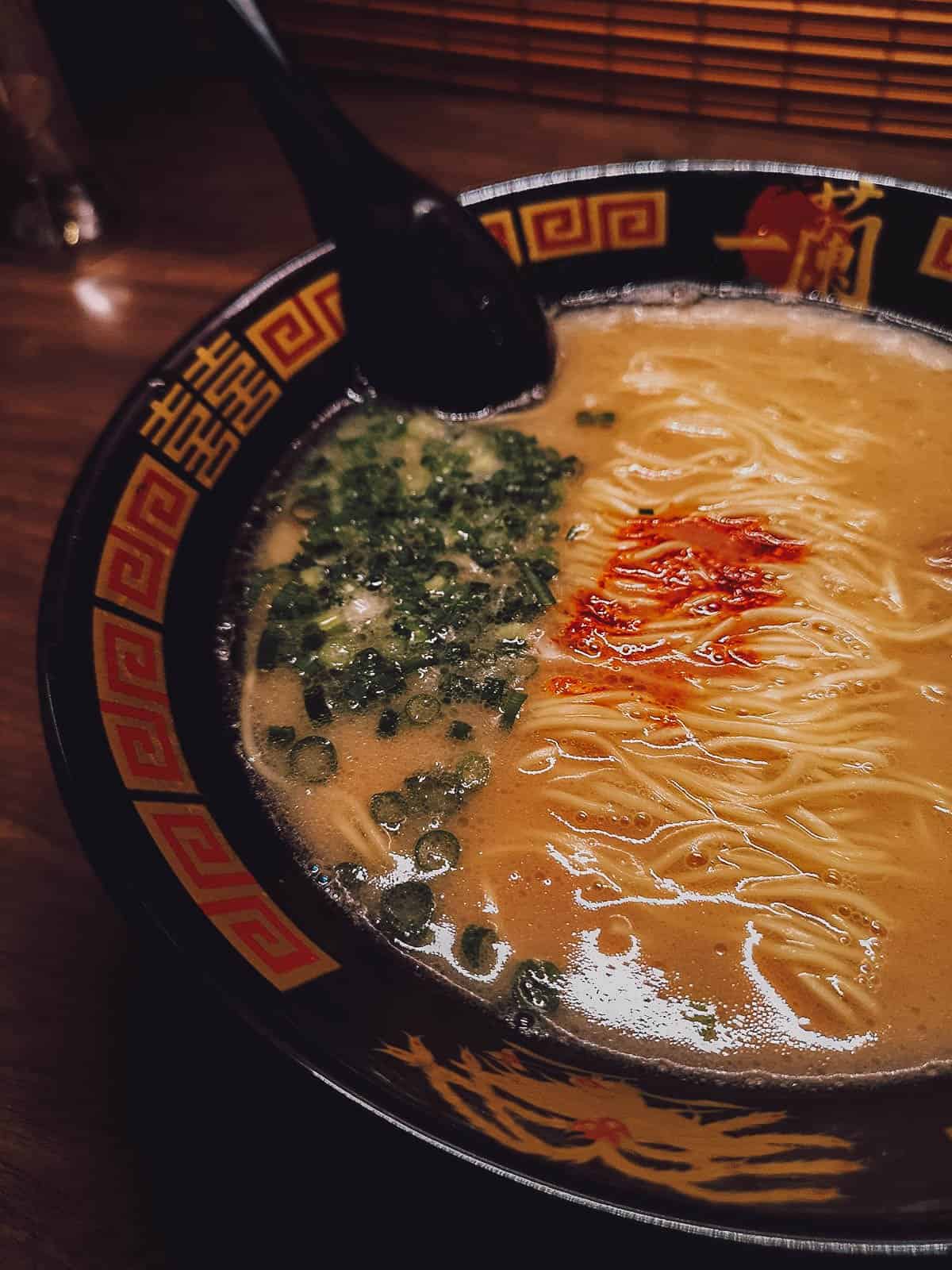
Ichiran is awesome, but if you aren’t an introvert and would prefer to enjoy a bowl of Hakata ramen with other people, then you may be interested in this guided ramen tour.
Experience teamLab Forest
Have you heard of teamLab Borderless? It’s an immersive art installation and sensory experience that aims to “navigate the confluence of art, science, technology, and the natural world”. In other words, it’s a trippy digital art show that was practically made for your Instagram or TikTok feed.
In Fukuoka, teamLab has put together a similar installation called teamLab Forest. I’ve been to teamLab Borderless in Tokyo but not to this one. Based on the pictures, it looks like more of the same but with a different theme.
You can pay for entry at the gate but considering teamLab’s popularity, it’s highly recommended that you book tickets in advance.
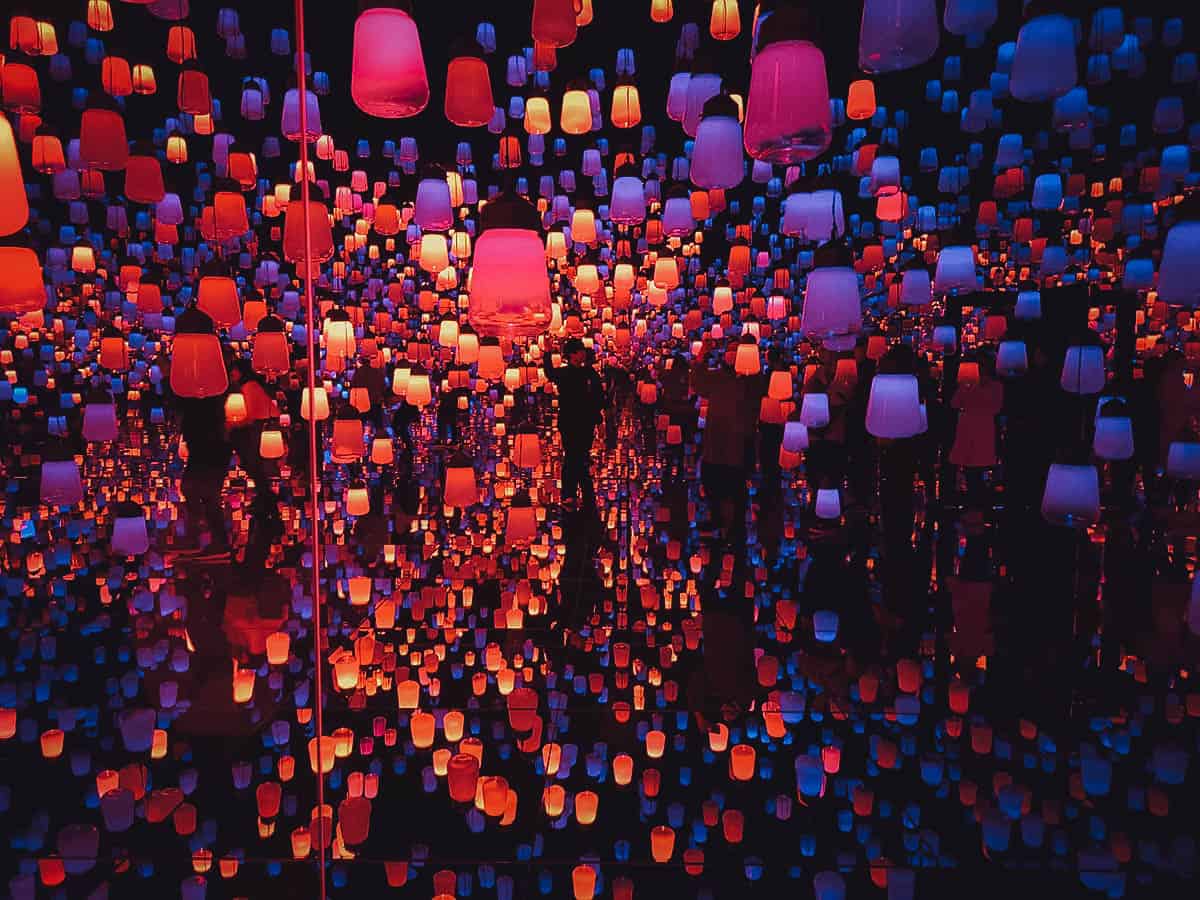
NOTE: The photo above is from teamLab Borderless in Tokyo.
Enjoy the Views From Fukuoka Tower
If you like lofty views, then you may want to visit Fukuoka Tower. At 234 meters tall (768 ft), it’s Japan’s tallest seaside tower and features an observation deck with 360° views from 123 meters (404 ft) above the ground.
Fukuoka Tower is located on the shore of Hakata Bay. The nearest metro station is about 1.5 km away so it’s best to catch a bus from Hakata Station. You can purchase tickets to the observatory at the door or in advance through Klook.
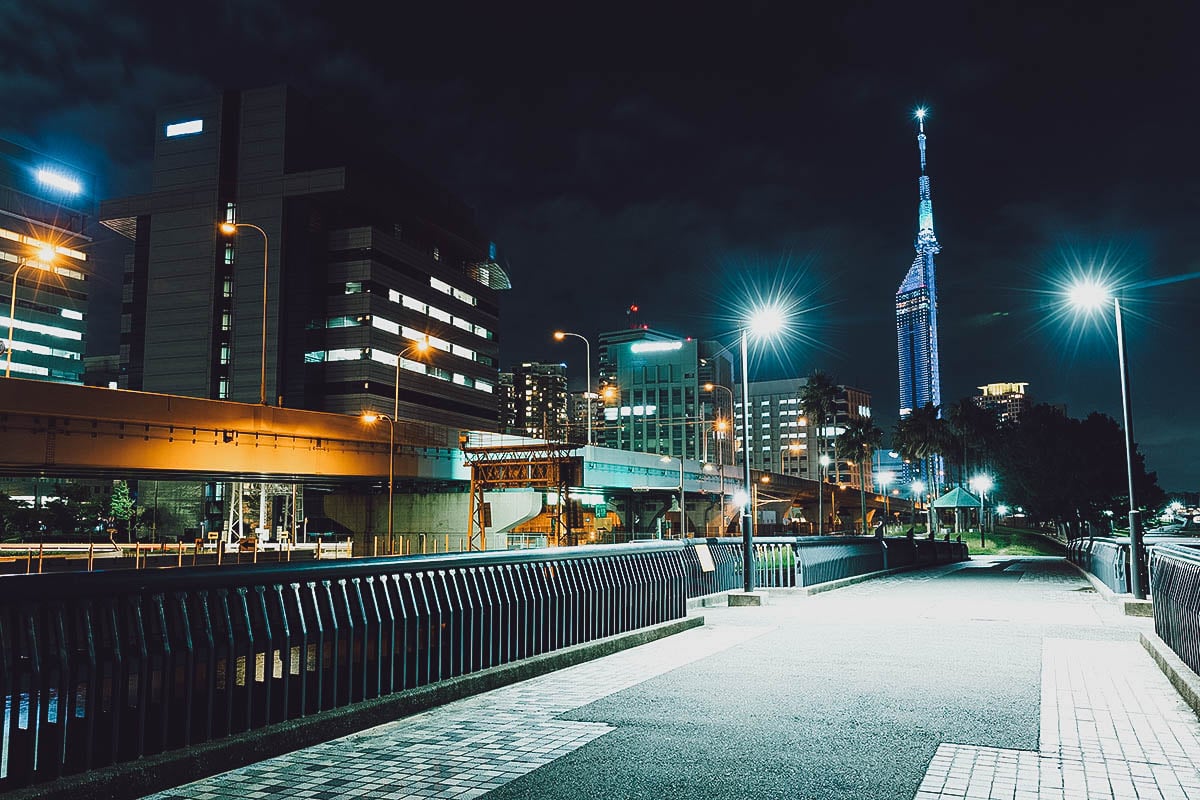
Photo by leungchopan via Depositphotos
Do Nothing at Ohori Park
Ohori Park is a spacious public park featuring the ruins of Fukuoka Castle and a large pond that used to be part of the castle’s moat system. Ohori in Japanese means “moat”.
Unfortunately, not much of the castle remains except for a few walls and lookout points but the pond is a great place to relax and while away the time on sunny days. You can also visit Ohori Park Japanese Garden and the Fukuoka Art Museum, both of which are located on the eastern side of the pond.
You can easily visit Ohori Park on your own but if you’d like to go as part of a guided tour, then you can book one through Klook.
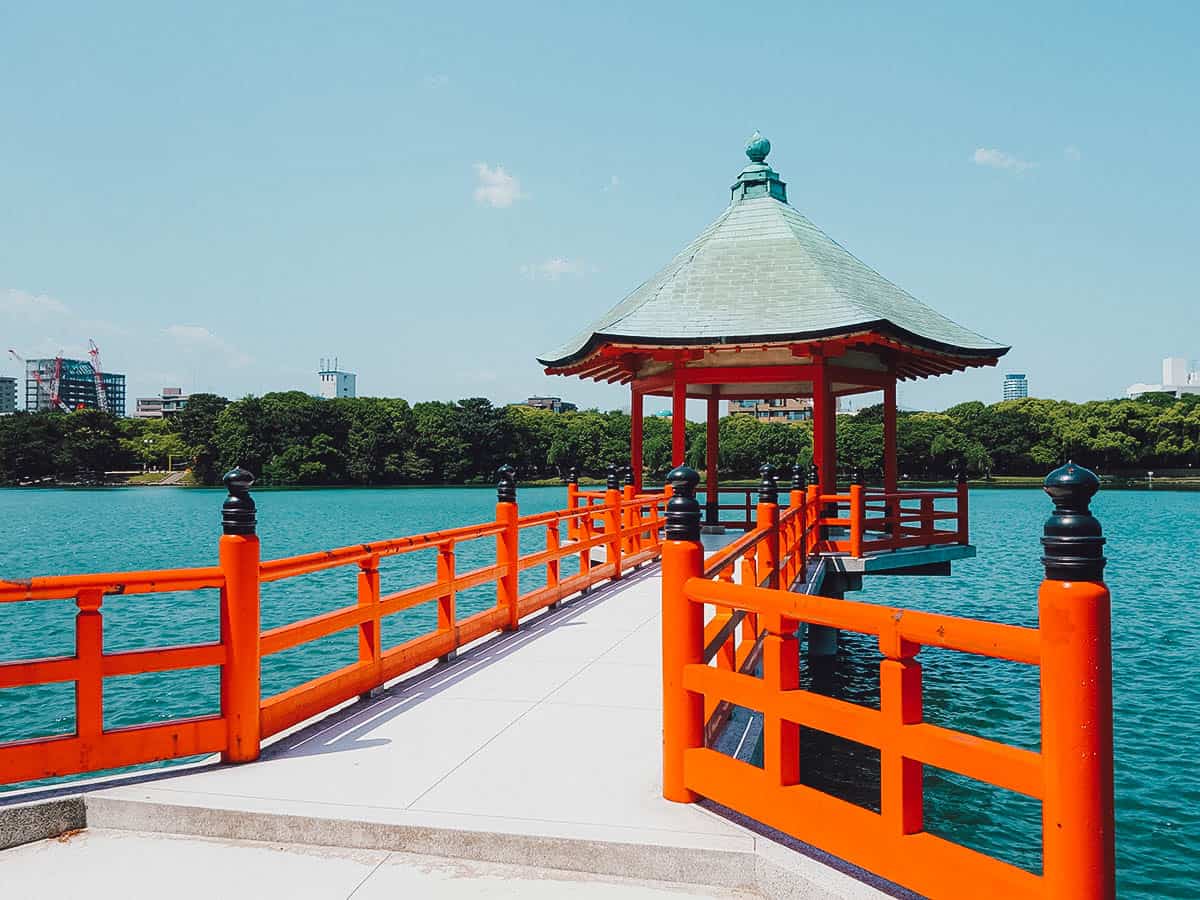
Photo by jacky-kou via Shutterstock
Take a Cooking Class
I enjoy taking cooking classes when I travel. For me, it’s one of the best ways to learn about a foreign cuisine. I didn’t take one in Fukuoka but I did take a cooking class in Tokyo where I learned to make Japanese favorites like udon, tempura, and tamagoyaki. It was super fun.
If you’d like to take a cooking class in Fukuoka, then you can search through airKitchen to find a class that suits you. You’ll have dozens to choose from.
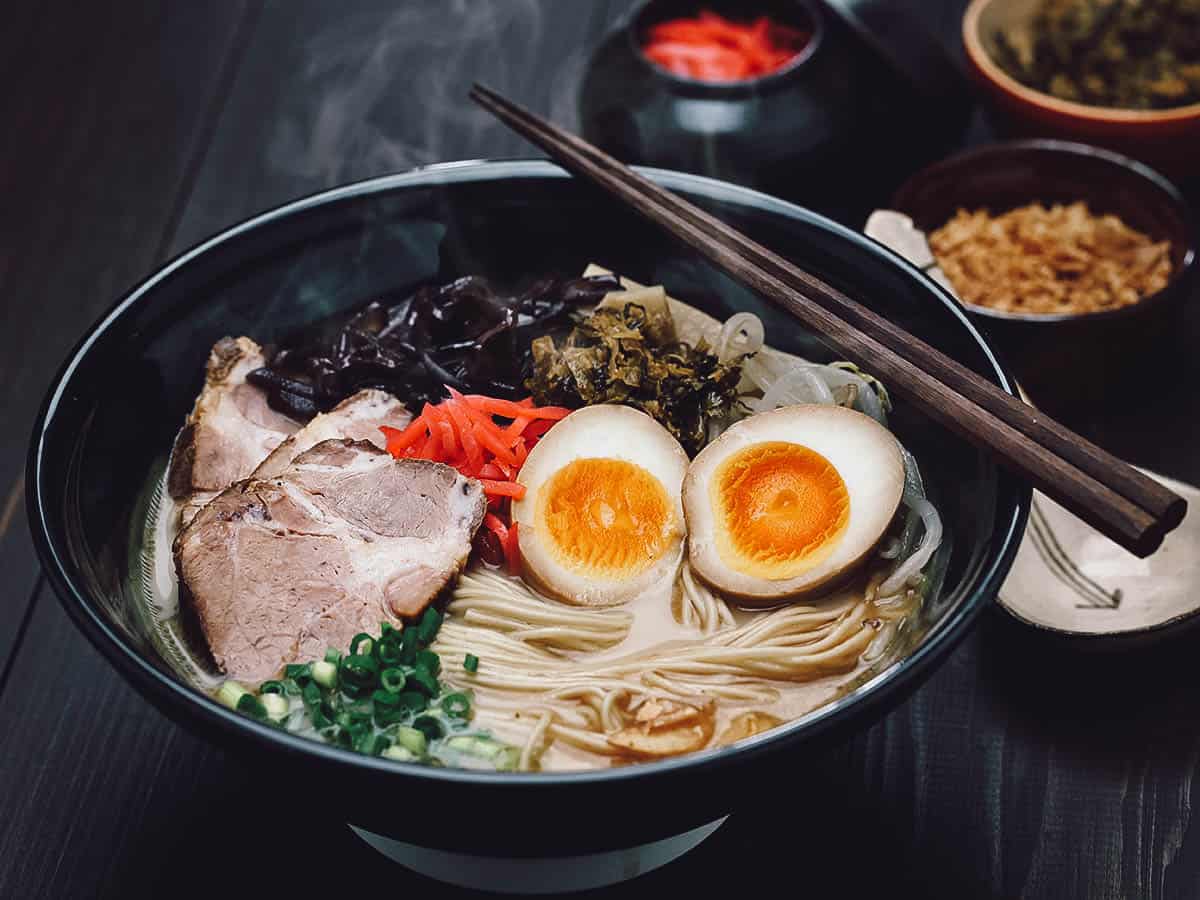
Photo by bonchan via Shutterstock
DAY TRIPS FROM FUKUOKA
These are some of the most popular but be sure to check out my full list of day trip destinations from Fukuoka for more suggestions.
Nanzoin Temple
Nanzoin Temple is probably the most well-known day trip destination from Fukuoka. It’s a Buddhist temple that’s home to a giant reclining bronze Buddha statue measuring 41 meters long (135 ft), 11 meters high (36 ft), and weighing in at nearly 300 tons. It’s said to be the biggest bronze statue in the world.
To get to Nanzoin Temple, catch a train to Kido Nanzoin-mae Station. From there, it’s about a 3-minute walk to the temple.
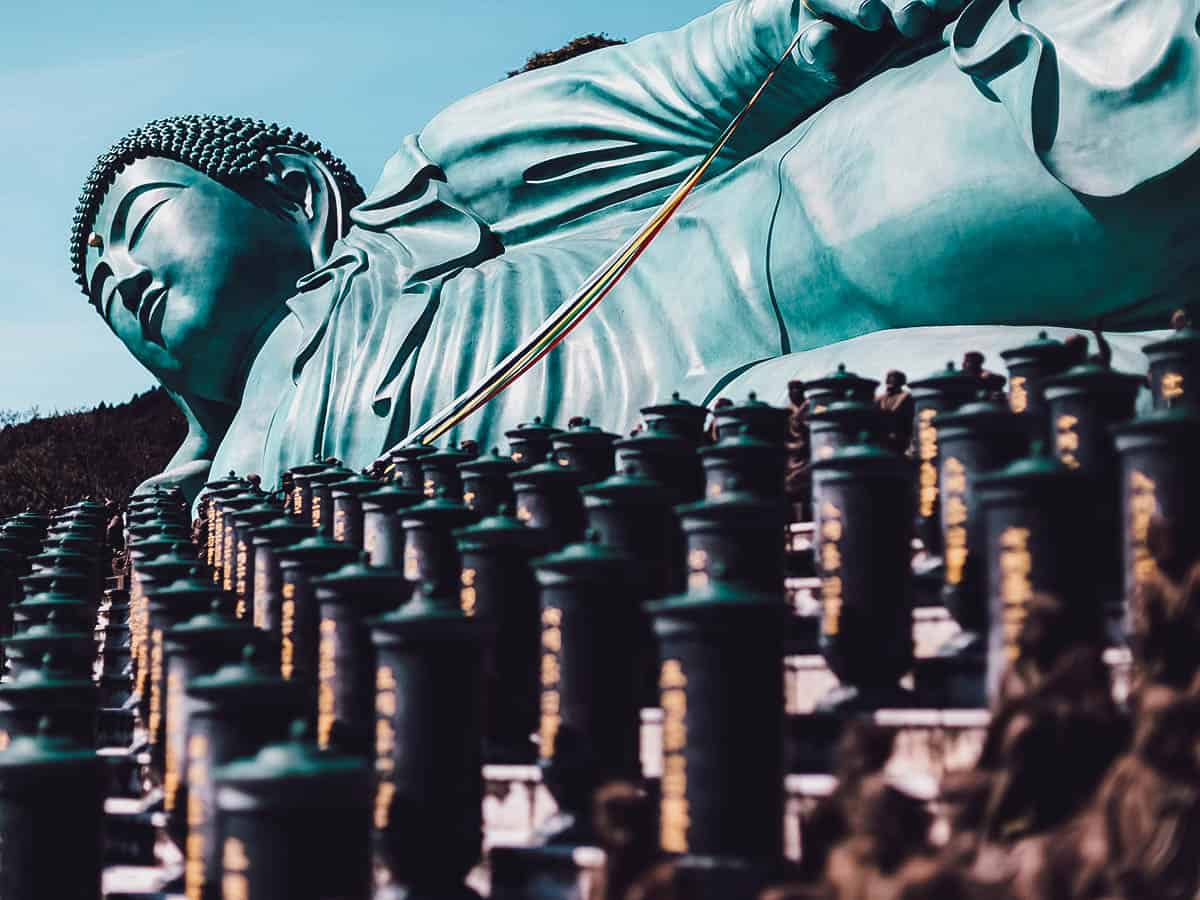
Photo by Thana Thanadechakul via Shutterstock
Dazaifu
The city of Dazaifu was once the administrative center of Kyushu. It no longer serves that role but it remains a key point of interest on the island with its many temples and shrines, none more important than Dazaifu Tenmangu Shrine. It’s also home to the Kyushu National Museum, a large museum that hosts collections of Japanese artifacts related to the history of Kyushu.
Dazaifu is about 45 minutes away so you can easily visit on your own by bus from Hakata Bus Terminal. If you’d rather go on a guided tour, then you can book one through Klook.
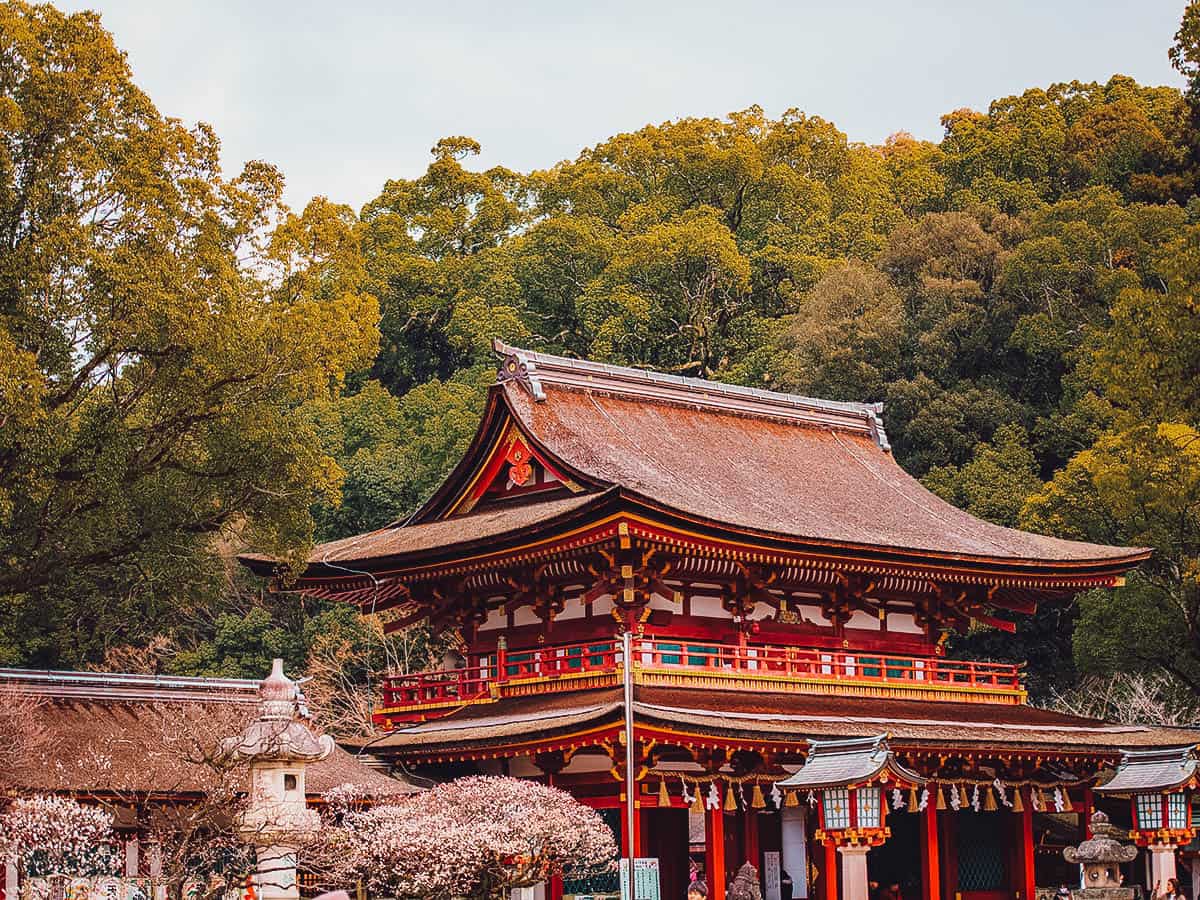
Photo by grandspy_photos via Shutterstock
Yanagawa
Yanagawa City is often referred to as the “city of water” or the “Venice of Kyushu” because of its famous network of canals totaling about 470 km (292 miles) in length. These canals were built for irrigation centuries ago but today, they’re used mainly to take tourists on cruises using boats propelled by boatmen with bamboo poles.
Aside from its canals, Yanagawa is famous for a steamed eel dish known as unagi seiro mushi. Unagi and strips of egg are layered over rice then steamed together in a bamboo steamer.
You can get to Yanagawa in less than an hour by train but if you’d prefer to go on an organized tour, then you can book one through Klook.
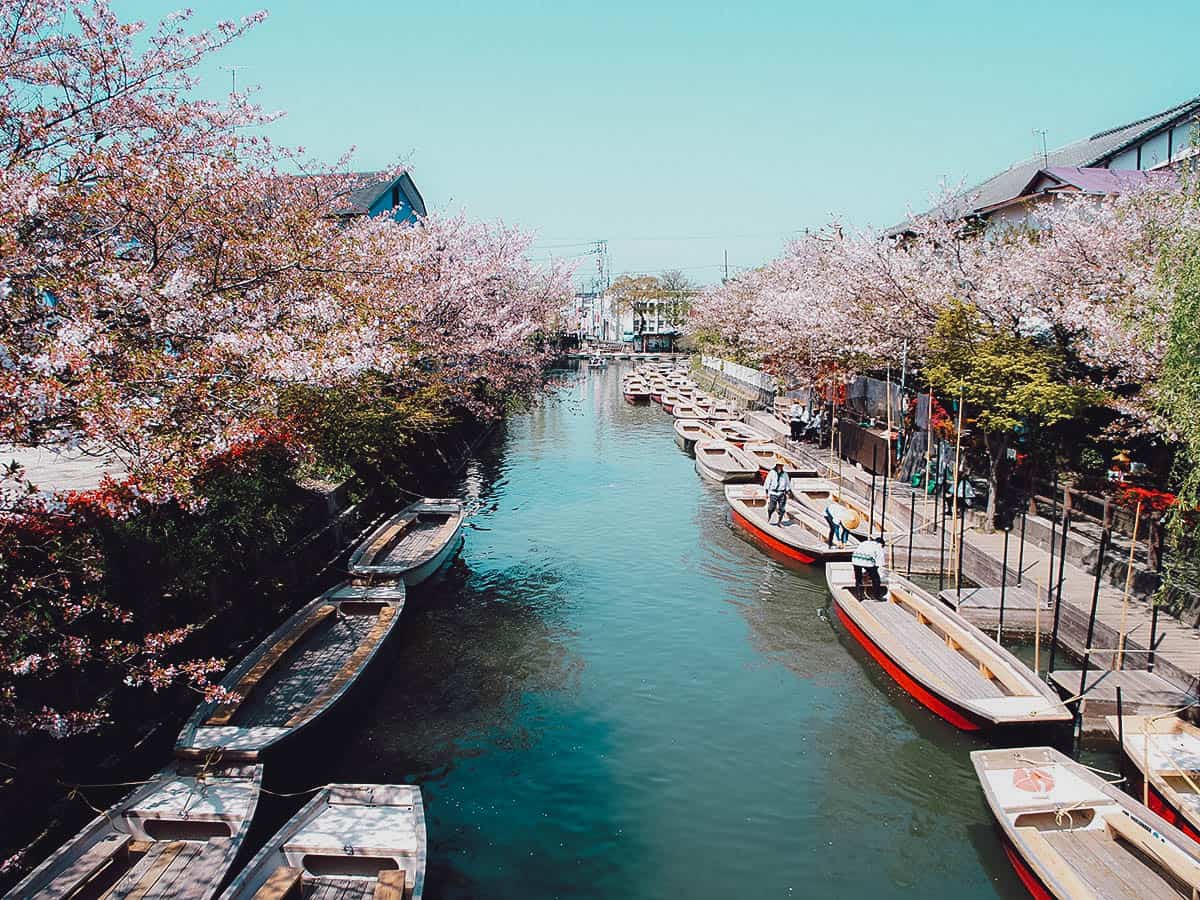
Photo by Hiya Hiyo via Shutterstock
VISIT FUKUOKA FAQs
Is Fukuoka worth visiting?
It depends. If it’s your first trip to Japan, then probably not. Fukuoka is a big city but it lacks the energy and cultural interest of more popular tourist destinations like Tokyo and Kyoto.
If you’ve had your fill of those cities and want to go off the beaten path in Japan, then yes, Fukuoka is definitely worth it, especially if you’re a fan of Japanese food.
How many days do I need in Fukuoka?
Fukuoka doesn’t have as many tourist attractions so you can easily see its highlights in a day. Stay for two if you plan on going to teamLab Forest or doing a day trip.
Is it easy to get around in Fukuoka?
Like any big city in Japan, Fukuoka has a great public transportation system. With that said, Fukuoka’s weather is mild and its top tourist attractions are in a fairly compact area so you may not need to use the subway as much. Whenever I visit Fukuoka, I get around mostly on foot.
I prefer getting prepaid IC cards in Japan but there are unlimited transport passes you can get in Fukuoka. The 1-day Subway Pass will give you unlimited use of the city’s metro system for one calendar day.
Another option is the Fukuoka Tourist City Pass. Aside from giving tourists unlimited use of virtually all Fukuoka metro and bus lines for one calendar day, it’ll provide discounted admission to a few tourist attractions as well.
I want to explore Kyushu island. What transportation pass can I get?
You can get the JR Kyushu Rail Pass. It’ll give you unlimited use of JR trains in Kyushu (except the Sanyo Shinkansen) for three, five, or seven consecutive days.
The Kyushu Rail Pass comes in three versions – All Kyushu, Northern Kyushu, and Southern Kyushu. You can use the All Kyushu and Northern Kyushu versions to travel to and from Fukuoka.
The Kyushu Rail Pass has the potential to save you a good amount of money if you use it often enough. You can use a JR fare calculator to estimate how much traveling by train will cost you. If it’s worth it, then you can purchase one in advance through Klook.
THE FINAL SAY
Fukuoka isn’t the most exciting or culturally enriching city in Japan but it’s worth a visit, especially if you plan on exploring the Kyushu region. It’s a big but more relaxed city that offers a welcome change of pace on your Japan trip.
If you’re a fan of ramen, then you’ll definitely want to spend a day or two there. Come to think of it, finding the best Hakata ramen spots is pretty much all I do when I visit Fukuoka!
Disclosure
This Fukuoka travel guide contains affiliate links, meaning we’ll earn a small commission if you make a booking or purchase at no additional cost to you. We only recommend products and services that we use ourselves and firmly believe in. We really appreciate your support as this helps us make more of these free travel guides. Arigato gozaimasu!
